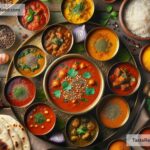The Evolution of French Haute Cuisine
French haute cuisine, famous for its elegance and flavor, is one of the most celebrated culinary traditions in the world. But its journey didn’t happen overnight—it evolved over centuries. Let’s take a look at how French haute cuisine, meaning “high cooking,” became such an important part of global gastronomy.
Early Beginnings: The Medieval Table
The roots of French haute cuisine can be traced back to Medieval France, a time when meals were grand and extravagant. Unlike today’s refined dishes, Medieval cooking focused on heavy flavors and rich ingredients. Large feasts often showcased meats, sauces, and hearty dishes cooked in large quantities. Spices like saffron or cinnamon were used to show wealth, as they were expensive and imported from distant lands. Cooking wasn’t about balance; it was about making an impression.
Meals were a public display of social status, especially for royalty and the wealthy. People didn’t eat individually; instead, food was served communally, often on large platters for everyone to share.
Refining the Table: The Renaissance
By the Renaissance (14th–17th century), French cuisine started to shift toward refinement. This was partly influenced by Italy. Italian cooks introduced skills like baking pastries, making desserts, and using fresh herbs to enhance flavors. When Catherine de’ Medici from Italy married King Henry II of France in the 16th century, she brought her Florentine cooks and culinary practices to the French court.
During this period, meals became more structured, with an emphasis on creating individual plates rather than communal servings. Chefs focused on balancing flavors more carefully, developing sauces, and experimenting with new recipes.
It was also during the Renaissance that cookbooks became more popular, helping spread knowledge about techniques and recipes across households.
French Cuisine Takes the Lead: The Age of Louis XIV
The reign of King Louis XIV (1643–1715) marked a turning point for French gastronomy. Known as the “Sun King,” Louis XIV loved food and surrounded himself with lavish meals at his court in Versailles. He demanded finer ingredients, better presentation, and more innovative cooking techniques. Feasts at Versailles became famous for their grandeur and creativity.
This era also gave birth to the idea of professional chefs working for wealthy households, not just royalty. Chefs developed cooking into an art form, establishing distinct courses (appetizer, main, and dessert) and experimenting with smaller, elegant portions rather than overwhelming platters.
It was during this time that French bread gained worldwide fame. The baguette, croissants, and other baked goods became staples, thanks to improved baking methods. Wine also became a central feature of French meals, paired carefully with courses to enhance the dining experience.
Haute Cuisine Gets Organized: The 18th & 19th Century
The 18th and 19th centuries saw the rise of French haute cuisine as something systematic and organized. Culinary pioneers such as Antonin Carême and Georges Auguste Escoffier began formalizing French cooking practices.
-
Antonin Carême (1784–1833) is often called the “King of Chefs and Chef of Kings.” He was one of the first to bring elegance and precision to cooking. He focused on creating elaborate dishes that blended artistic presentation with sophisticated flavors. Carême wrote many books and codified French cooking methods, cementing France’s reputation as a culinary leader.
-
Auguste Escoffier (1846–1935) refined Carême’s ideas and simplified them. Escoffier introduced the “brigade system” in kitchens, dividing the staff into specialized roles (sauciers, pâtissiers, etc.), which is still used today in professional kitchens. He also created many iconic French dishes and helped popularize haute cuisine internationally.
During this time, restaurants became common across France. This allowed the public to experience finely crafted meals in elegant dining rooms, making haute cuisine accessible beyond the aristocracy.
Modern Influences: Nouvelle Cuisine
By the 20th century, traditional French cooking faced a significant change through a movement called nouvelle cuisine. This modern style of cooking focused on lighter dishes, fresh ingredients, and simpler preparations.
Nouvelle cuisine challenged the heavily sauced and rich dishes of earlier haute cuisine. Instead, food was cooked minimally to preserve natural flavors. Plates often featured colorful vegetables, delicate proteins, and creative pairings.
While nouvelle cuisine simplified some aspects of French cooking, it kept the focus on visual presentation and artistry. Chefs like Paul Bocuse, Alain Chapel, and the Troisgros brothers were key figures in this movement.
Today: French Cuisine and the Global Stage
French haute cuisine continues to evolve in today’s world, blending tradition with innovation. Michelin-starred restaurants, gastronomic tours, and televised cooking competitions showcase how French chefs push boundaries while honoring their culinary heritage.
France is still known for its iconic dishes like coq au vin, ratatouille, boeuf bourguignon, and crème brûlée, but it’s also embracing modern trends like molecular gastronomy and plant-based cooking.
Additionally, French haute cuisine isn’t just for the elite anymore. Though luxury restaurants still exist, many chefs offer accessible options so more people can experience the artistry of French cooking.
Conclusion
The evolution of French haute cuisine is a story of transformation. From Medieval feasts to today’s Michelin-starred creations, it has continuously adapted while maintaining its elegance and attention to detail. The tradition honors chefs like Carême and Escoffier while embracing innovation to thrive in a changing world.
Whether you’re savoring a buttery croissant or experiencing a multi-course tasting menu, French haute cuisine remains a symbol of creativity, craftsmanship, and passion—a delicious journey that has captivated food lovers for generations.

